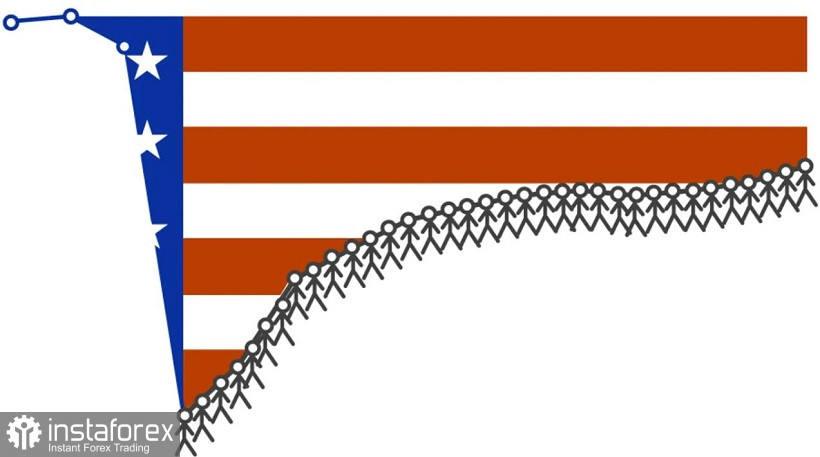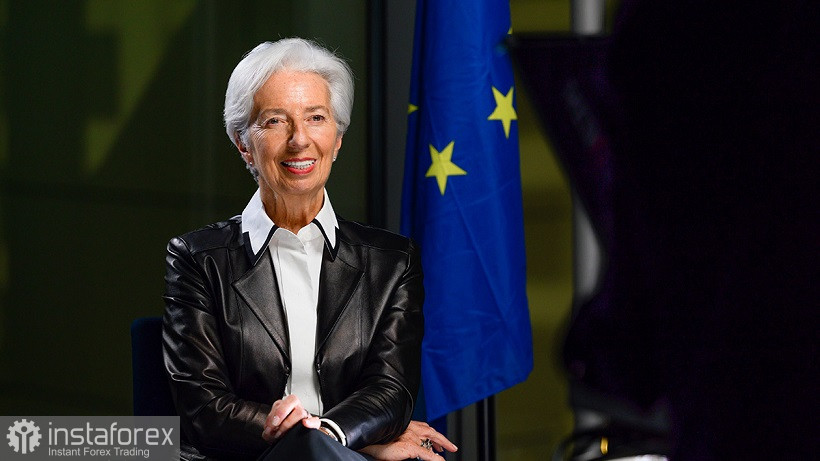The euro-dollar pair retreated from annual lows after a two-day impulse decline and drifted in a narrow price range. EUR/USD bears failed to consolidate below the lower line of the Bollinger Bands indicator on the daily chart (1.1540), after which they hurried to lock in profits, thereby providing indirect support to buyers. However, EUR/USD bulls are also not active – the pair is "circling" around the 1.1550 target, demonstrating weak volatility. On the eve of tomorrow's release, investors risk opening large positions - neither in favor of the dollar nor (especially) against it. The market froze in place in anticipation of a strong information driver. In other words - calm before the storm.

Preliminary signals are encouraging. For example, yesterday's report from the ADP agency came out in the green zone, stating the creation of more than half a million jobs in the private sector. A month ago, this report showed a fairly high correlation with the official release, so the strong figures of September suggested that tomorrow the main components of the publication will please dollar bulls with a "green color." Forecasts regarding September Nonfarm Payrolls also suggest that the American labor market will at least not disappoint.
Thus, the unemployment rate should decrease to 5.1% (a systematic decline in the indicator has been observed for 14 months in a row), and the number of employed in September should increase by 490,000. Note that this indicator has been steadily growing for three months (from May to July), showing a record millionth result in the middle of summer. But in August, this indicator collapsed to 235,000 (with a forecast of growth to 740,000). Therefore, the half-million result in September will look like a kind of "compromise" that will certainly support the US currency.
A weekly increase in initial applications for unemployment benefits was published in the US on Thursday. After three consecutive weeks of growth, it dropped sharply (326,000 with a forecast of growth to 370,000), ending up in the "green zone." This fact also provided indirect support to the greenback.
And yet the intrigue about Friday's release persists. Traders are in no hurry to open longs or go into sales for the EUR/USD pair, bearing in mind the disappointment of the August Nonfarm Payrolls. That is why weak downside impulses fade almost immediately on Thursday. Sellers are mostly "on the fence," frightened by the prospects of possible stagflation. If Friday's data comes out in the "red zone," concern about this will only increase, putting pressure on the greenback. Otherwise, dollar bulls will organize another rally.
Despite the current uncertainty, EUR/USD buyers cannot seize the initiative for the pair to organize a corrective growth. The minutes of the last ECB meeting published on Thursday was not in favor of the single currency. After this release, the euro collapsed in many cross-pairs (in particular, EUR/GBP, EUR/CHF).
The essence of the published document boils down to the fact that the European regulator will ignore the current increase in inflation. According to ECB representatives, the short-term growth of inflation indicators was provoked by temporary factors, the influence of which will weaken "in the medium term." At the same time, the members of the Governing Council unanimously agreed that current trends allow the Central Bank to "moderately" reduce purchases under PEPP in the last months of the year. Recall that Christine Lagarde, following the results of the September meeting, did not specify when exactly the ECB will begin to slow down the pace of PEPP. By all accounts, this should happen in November or December. The minutes of the September meeting indirectly confirmed this version. However, according to the same protocol, even without the PEPP program, the ECB's monetary policy will remain accommodative. Most members of the Governing Council are confident that a soft monetary policy is still necessary for the European economy.
But the question regarding the future fate of the asset-purchase program (APP) remained unresolved. On the eve of the September meeting, some experts admitted the possibility that the Central Bank could announce or hint at the expansion of this program, the volume of which currently amounts to 20 billion euros per month. According to one version, the ECB will almost double this amount next spring. But, as it turned out, the regulator is in no hurry to discuss this issue. The protocol states that the members of the Council decided to "wait for new information" before making decisions regarding the APP.

Thus, the protocol published on Thursday once again reminded market participants about the uncorrelation of the ECB and the Fed rates. Given this fact, it can be assumed that the euro will continue to move in the wake of the US currency, which in turn is waiting for the Nonfarm Payrolls report. The circle, as they say, has closed: the fate of the downside trend (at least in the medium term) depends on Friday's release.
At the moment, it is advisable to take a wait-and-see attitude for the pair. The technical side of the issue speaks about the priority of short positions (the price is located between the middle and lower lines of the Bollinger Bands on D1 and under all the lines of the Ichimoku indicator), but if Friday's figures disappoint investors, we will witness a fairly large–scale correction - at least to the level of 1.1630 (Tenkan-sen line) or even to 1.1690 (the middle line of the Bollinger Bands). If the indicators come out in the green zone, then we can count on breaking through the support level of 1.1540 with further testing of the "round" mark of 1.1500.
 English
English 
 Русский
Русский Bahasa Indonesia
Bahasa Indonesia Bahasa Malay
Bahasa Malay ไทย
ไทย Español
Español Deutsch
Deutsch Български
Български Français
Français Tiếng Việt
Tiếng Việt 中文
中文 বাংলা
বাংলা हिन्दी
हिन्दी Čeština
Čeština Українська
Українська Română
Română

